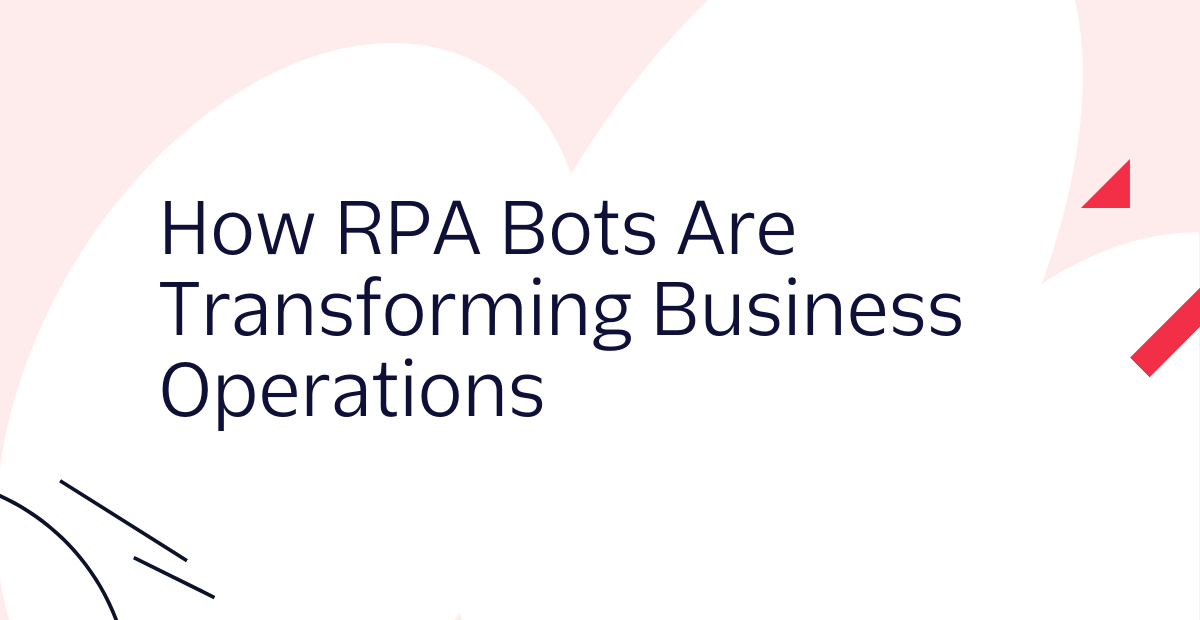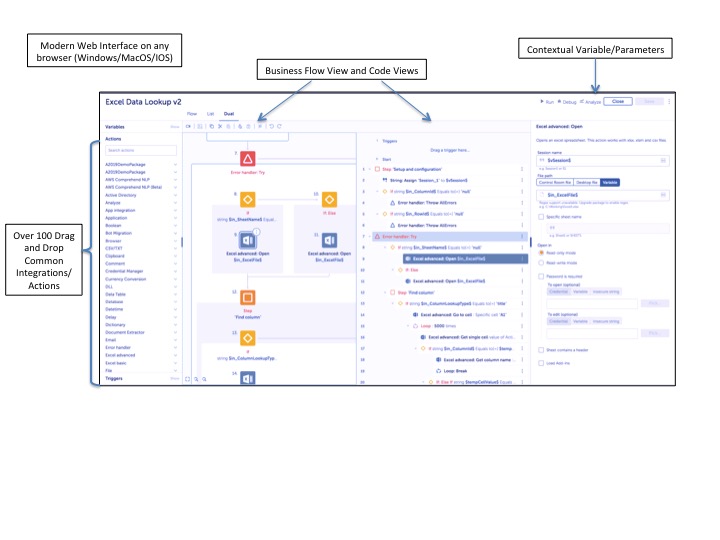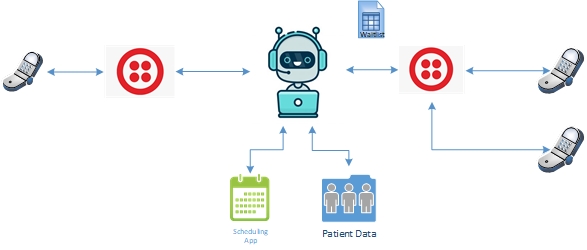How RPA Bots Are Transforming Business Operations
Time to read: 6 minutes

Robotic process automation (RPA) is an emerging transformational technology that automates business processes with software robots. RPA is important to nearly every vertical and is poised to have a lasting, critical impact on organizations.
But what exactly is RPA? What are its benefits and challenges? And where should RPA bots be deployed? Let’s answer those questions, then look at a sample use case using Twilio and RPA to automate healthcare appointment rescheduling.
What are RPA bots?
RPA is a technology that creates digital workers (aka bots) that emulate a human’s actions when interacting with digital systems to execute a process. In short, RPA bots perform actions just as humans would—logging in, entering data, interpreting results, sending emails, copying text, performing calculations, filling out forms, sending files, and more. And RPA bots do this all faster, more reliably, and at a fraction of the cost of a human.
These bots increase operational savings, workforce quality of life, quality control, and overall competitive advantage by automating highly repetitive, routine tasks usually executed by humans.
For example, an airline significantly impacted by COVID-19 built an RPA bot—in just 6 days—that handled 80% of the airline’s cancellation requests. In another case, Takeda used RPA to recruit for clinical trials of a COVID-19 treatment and cut enrollment time down. Takeda plans to scale up its automation to save 4.6 million hours of office work per year in the near future.
RPA promises that a farm of digital workers can complete these highly-repetitive processes, allowing the newly-released human bandwidth to deploy to higher-value activities.
In other words: no more legions of workers performing mindless, repetitive tasks from 9 to 5. Let the machines take care of it.
Benefits of RPA bots
As RPA products have evolved, so have the benefits. RPA bots are now highly scalable, secure, and compatible with other enterprise products. As such, these bots offer numerous benefits, including:
- RPA typically requires no custom software, no complicated integrations, and costs a fraction of the time and money a human would take to complete the task.
- RPA bots are more productive than humans. These bots are faster, work 24/7, and are scalable. Nielsen, for example, created a specialized RPA strategy to automate manual tasks across 20+ business units and 40+ countries, saving more than 347,000 hours over 18 months.
- RPA robots are accurate, consistent, and help ensure compliance. For example, the US Bureau of Labor Statistics automated 85% of the work needed to convert text records into codes for work-related injury surveys, greatly improving reporting accuracy.
- RPA bots can be ramped up and throttled down.
- RPA has a quick return on investment (ROI).
- RPA bots typically use existing infrastructure and systems, minimizing disruption to your current systems and processes.
- RPA can accelerate your digital transformation by extending the life of legacy applications and creating straightforward integrations between systems.
- RPA can create a better employee experience by automating repetitive and boring tasks, freeing employees to focus on more interesting, challenging, and higher-value tasks.
Challenges with RPA bots
Of course, there are always challenges with transformative technologies—and RPA is no different. Several common challenges include:
- RPA bots aren’t smart. The lack of intelligence can lead to rigid behavior that wouldn’t occur with a human in the loop.
- RPA makes it difficult to capture undocumented tribal knowledge performed by workers executing the process.
- RPA is often limited to a small handful of bots due to organizational scaling challenges—and underestimating budgets and resources.
- RPA locks operations into a standardized business process that can inhibit your company’s agility in the face of changing markets.
- RPA can eliminate many jobs, presenting challenges in managing and retaining talent.
- RPA can introduce complexity. And because organizations often jump onto the RPA bandwagon quickly, it often means skipping established and robust processes, such as risk analysis and assessment.
Where to deploy RPA bots
Today, businesses deploy bots in nearly every department.
For example, companies frequently create bots in finance and accounting. In these areas, processes are often well-defined, and the efficiency results in visible cost reductions. Human resources is another area for RPA, where there’s a significant volume of transactional, back-office processes.
Other common areas of the business for RPA include logistics (invoicing, tracking, scheduling) and IT (server monitoring, batch processing, password resets, backups).
To identify processes ideal for RPA in your organization, keep in mind that RPA truly shines with stable processes where bots can look/click/type, just as a human would. These processes are:
- Rule-based
- Time-consuming
- Repetitive
- High volume
- Decomposed into steps discreetly
- Mature and stable
- Built around structured data (data that’s predictable and conforms to constraints, such as SQL databases, well-structured XML, and even common paper forms) and structured applications (applications that are predictable and conform to constraints)
Integrating RPA bots with Twilio: Aa use case
Now let’s take a look at how one RPA tool—Automation Anywhere—integrates with Twilio.
Many RPA vendors offer bot marketplaces that allow you to extend the core functionality of products. Most market leaders provide free extended integration packages for the Twilio API.
The Twilio API is a natural fit for RPA because both back-end automation and end-to-end RPA often need to communicate with users—which Twilio can facilitate with ease as a cloud-based API built for customer communications. And since Twilio is a cloud-based API that integrates functionality (such as SMS, VoIP, IVR, video, and more), it can be called by bots built in numerous tech stacks, regardless of whether the bots live on-prem or in the cloud.
In short, integrating with Twilio gives your RPA bots a wider scope of automation.
Automation Anywhere
Automation Anywhere is a cloud-based, low/no-code solution for creating RPA bots. It’s also a great tool for exploring some of the functionality you can achieve with RPA and Twilio.
Below, in the left panel of the user interface, there are over 100 different integration points, each with different sets of actions that the bot can perform. You can create bot automations by dragging and dropping actions and integrations into either the flow or list for the automation. On the right, each of the commands has specific fields to implement the action (such as file name for an open command).

Automation Anywhere Dashboard for Creating an RPA Process
When analyzing a use case for RPA potential, it’s helpful to break the case into several components. For each use case we’ll create:
- An overall description of the use case
- The “as-is, human-driven process”—or how humans currently perform the process
- The applications (software and hardware) that need integration
- A “to-be” analysis of the proposed solution
- The final proposed automation flow
Use case: Healthcare appointment rescheduling
Description:
Our example considers a patient who sends a text to a healthcare provider to cancel an appointment. This is an extremely common task, with a known set of actions and responses, making it a great candidate for RPA.
As-is, human-driven process:
A patient texts the office to cancel an appointment. Office staff members receive the text, enter the cancellation into the appointment manager software, then contact other patients on a wait-list for that physician to see if any are available for that date/time. Upon a positive response, an office staffer enters the new appointment into the system.
Applications integrated:
SMS, scheduling application, medical records database, spreadsheet
To-be analysis:
A key consideration for this process revolves around accessing the scheduling application and algorithm for wait-list rescheduling. To our benefit, we don’t have to do everything inside the RPA. In many cases—such as this one—much of a task’s logic already lives inside the applications (such as scheduling and email notifications).
We’ll use Twilio, in this example, to handle our text messaging to and from the patients.
Proposed automation:

- Populate and maintain a wait-list spreadsheet when patients call, but no appointments are available
- When a text is received with the word “cancel”:
- Extract the phone number from the text
- Enter that number into the scheduling application
- Click the button that cancels the appointment
- Return the time slot now available for the doctor
- Send an acknowledgment to the person canceling
- Loop over the wait-list spreadsheet:
- Text the number, informing patients when there’s an appointment available with the time, and ask the patient to reply with “accept” or “decline”
- If the corresponding return text is “accept”
- Enter the number into the scheduling application with the time
- Take the patient key info and retrieve that medical history for the appointment
- Exit Loop
- If the corresponding return text is anything else, or a set timer expires
- Loop again with the next number

How the Automation Looks in Automation Anywhere
Getting started with RPA bots in Twilio
The RPA wave is here. Most organizations aren’t just exploring automation but are already achieving enviable ROI, streamlining workflows, saving time and money, and freeing employees from mundane and repeatable tasks. Combining RPA with Twilio promises to drive your organization forward by merging rote tasks with the power of programmable communications.
Are you ready to integrate RPA bots into your processes with Twilio? Download our white paper to learn everything you need to know (and more!) about how your business can leverage robotic process automation to improve organizational efficiency and productivity.
Related Posts
Related Resources
Twilio Docs
From APIs to SDKs to sample apps
API reference documentation, SDKs, helper libraries, quickstarts, and tutorials for your language and platform.
Resource Center
The latest ebooks, industry reports, and webinars
Learn from customer engagement experts to improve your own communication.
Ahoy
Twilio's developer community hub
Best practices, code samples, and inspiration to build communications and digital engagement experiences.


